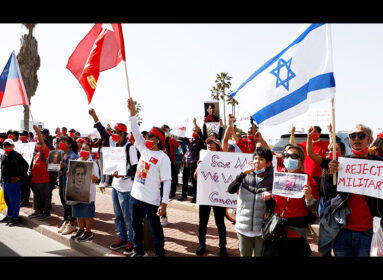
Recreating the poignant story of how one Jewish family escaped Czarist Russia and re-established itself in America was like solving a mystery by unpacking a suitcase filled with postcards, photographs, and other ephemera.
By Cindy Mindell
NEW HAVEN – Patricia Klindienst didn’t set out to become the “rememberer” of a family not her own. She was working on a book about the gardens created by immigrants in America and mentioned the project to her friend, Alice Linder.
“Alice said, ‘Did I ever tell you that gardening played a role in my grandfather’s escape from Czarist Russia?’” Klindienst recalls. Linder didn’t know many details of Abram Spiwak’s migration from Eastern Europe to the United States, but she gave Klindienst a five-page memoir transcribed by Spiwak’s niece late in his life. Klindienst began asking Linder’s relatives for stories and artifacts and soon had amassed a collection of the dots – oral histories, photographs, and postcards – that, when linked together, began to chart the course of a Jewish immigrant family from the Old World to the new.
Seven years later, in December 2013, the Yiddish Book Center in Amherst, Mass. introduced Klindienst’s exhibit, “No One Remembers Alone: Memory, Migration, and the Making of an American Family.” Now, the visual chronicle of Abram Spiwak and his wife, Sophie Schochetman Spiwak, recreated through the postcards, photographs, and other ephemera retrieved from many drawers and suitcases, is on view at the Slifka Center for Jewish Life at Yale through early 2015.
Klindienst, a Guilford-based writer, teacher, and scholar, is no stranger to the American immigrant experience, a topic she has made her professional focus for more than a decade. A graduate of Hampshire College, Boston University, and Stanford University, she began her career as an interdisciplinary scholar at Yale, publishing groundbreaking feminist reinterpretations of classical myths and biblical stories, including The Voice of the Shuttle Is Ours, winner of a 2007 American Book Award; Ritual Work on Human Flesh: Livy’s Lucretia and the Rape of the Body Politic; and Intolerable Language: Jesus and the Woman Taken in Adultery.
Her first nonfiction book, The Earth Knows My Name, tells the stories of 15 ethnic Americans who transmit their cultural heritage through their gardens. She wanted to include the story of Abram Spiwak – his training at an agricultural school in Russia, funded by Baron Maurice de Hirsch, and his early 20th-century farm in Queens, N.Y. But the profile didn’t fit: the portraits in the book were of living gardeners, and Spiwak had passed away.
Klindienst left the story out but couldn’t leave it behind, and began to reimagine it as the seed for a new book. She began researching the names found in his memoir – Kishinev, 1903 and Odessa, 1905, sites of horrific pogroms – and Baron Maurice de Hirsch, who funded educational initiatives for Jews throughout the world.
“The more I asked the family, the more I realized that they didn’t know their own history,” she says. “In this way, they are emblematic of the situation of third-generation Americans, as am I.” Klindienst interviewed nearly 40 members of the extended Spiwak family and found that, more than their spoken accounts, it was the visual aspect of the storytelling that compelled her attention.

Abram Spiwak’s seven sisters: (l to r) Rivke, Gitel, Feige (Fanny), Dvore, Sore, Chava, Chane. Portrait made in the Loshakov Studio, Orgeyev, Bessarabia, c1909. Photo courtesy of Phyllis Sarafconn.
With every box or drawer or suitcase emptied for her to see, the book’s outline grew thicker and thicker until the story couldn’t be held between two covers. She realized that she could best convey the narrative through the images on the hundreds of postcards among the artifacts – a “visual biography” so familiar to second- and third-generation descendants of Eastern European Jewish immigrants.
She proposed the idea for a show to the Yiddish Book Center and set about creating her first-ever exhibit, working with a friend who is a professional designer and her husband, who is an architect.
The core of “No One Remembers Alone” is the humble “real photo postcard,” an invention that coincided with Kodak’s inexpensive portable camera in the early 20th century. Now anyone could take photos, which could be printed onto thick postcard stock and sent through the mails.
“These were the Twitter of the time,” Klindienst says. “You could mail them for a penny and there were three mail deliveries a day. So, even a working-class Jewish immigrant could afford to buy and send them.”
Klindienst selected 48 of the hundreds of penny postcards she received from the Spiwak family, and arranged them into the exhibition’s two stories. One, unearthing voices from Russia and Romania, Argentina and the U.S., tells of how members of the Spiwak and Schochetman families escaped from Eastern Europe or stayed behind or, in one case, returned to Russia. The other chronicles the courtship of Abram and Sophie between 1907 and 1909, once the two had resettled in New Jersey and New York, respectively.
Klindienst provides the historical context that explains the handwritten accounts in Yiddish, Russian, Romanian, Spanish, French, and German. “This is about how the family, as they were separated by the pressure and need to emigrate, tried to keep in touch in any way they could, and the postcard was the cheapest, most effective way to do that,” she says.
As the design progressed, Klindienst realized that Abram and Sophie’s story could open a personal, intimate window onto a moment in Jewish history since overshadowed by the Holocaust, when the Russians were the arch-enemies of the Jews. For Klindienst, looking through that window led to simple questions with sweeping answers.
“I’m a third-generation American and, like me, most of the people I know and have talked to, whether Jewish or not, don’t know anything about their grandparents’ story of migration,” she says. “A great advantage of knowing nothing is that you ask very simple, obvious questions: Why did all these Russian Jews leave? How did they know how to get out? How did they know where to go? How did they go? How did they get the papers they needed? How did they get from the western border of Russia to ports of embarkation?”

Sept. 24, 1908. A postcard from Sophie to Abram exerting pressure on him to visit her family for Rosh Hashana. Jewish immigrants found it difficult to negotiate with their Christian employers for time off for Shabbat and holy days. Sophie insists that Abram will have no problem getting one day. Translation: Darling Abram, I am writing this postcard to you, although I do not have the leisure to write. The matter is that Father asked Mother whether you will come over at rosh-ha-shana, and Mother said that you will. So Mother explicitly asked me to write to you so that you definitely come. So I am asking you very much to come on Friday evening. I am positive that your boss will definitely not tell you anything [if you ask] for one day. I don’t want Mother to be saddened. I am waiting for the answer patiently. Yours, Sophia.
The postcards can also allow descendants of Eastern European immigrants to crack the language barrier so common among the generations. Because many third-generation American Jews don’t know the languages spoken by their grandparents, those immigration stories are mostly understood through photographs and indecipherable letters, leaving big holes in memory.
Klindienst wanted to know what every piece of written material had to say. At that point, the collaborative nature of the project expanded far beyond Alice Linder and her relatives. Klindienst would post images and written material on the Jewish Genealogy website, asking for translation help. Responses rushed in from around the world. “People leaped into it and said, ‘Send me anything; I’ll translate anything for you,’” says Klindienst, who is still in contact with several of the translators she worked with. She explains this unusual collaboration as “an overcoming of sorrow.” So many stories of Jewish migration tell of loss, she says. “I think everybody who has participated in this project has this sense of, ‘Isn’t it wonderful that something can be found.’”
Some 200 translators from 16 different countries helped tell the story. One day, after enough pieces had come together, the name of the exhibit popped into Klindienst’s head.
“Remembering is like a mosaic; you have to leave spaces open,” she says. “The desire for a continuous narrative is strong, but I learned that you don’t force the story, you just wait. One person’s story would give me a piece and another would give me another piece and each was contributing something. No one was remembering alone; their memories were memories that came with the family, the things they saw and heard.”
Remembering also includes the translating of the material. “Sometimes I’ll post a letter and people will begin to respond and then they respond to each other across the world,” Klindienst says. “A bond is created in that remembering together, and it starts this beautiful collaborative effort to retrieve from obscurity these words and these voices.”

The Milstein Family Passport Photo, 1921: (l to r) Rokhele (Rose), Chane, Israel, Peryl, Malka. Courtesy of Barbara Goldberg.
The discovery process wasn’t always emotionally easy, Klindienst says, as she came to know and love the family members, living and dead. During her six years of research, some discoveries forced her to stop cold. In the course of a day, she found the whereabouts of Sora, one of Abram’s six sisters who had stayed behind in Russia. Later, while combing through the online records of Yad Vashem, she read among the victims the names of Sora and her husband, son, daughter-in-law, and daughter-in-law’s parents.
“The day I found them, I lost them, and I thought that this must be what it’s like for Jewish families who go back to the Old Country to look for family members,” she says. “They find traces but then learn that their relatives didn’t survive and lose them again in an instant.”
The stories in “No One Remembers Alone” are echoed across the Atlantic, in the Red Star Line Museum in Antwerp. Opened in September 2013 in the historic warehouses of the Red Star Line shipping company, the sister museum to the Ellis Island Immigration Museum, the new museum tells the story of more than two million European men, women and children who travelled from Belgium to America on the Red Star Line’s ocean liners. An estimated one in four was of Jewish descent. Abram and Sophie’s story is part of the museum’s permanent exhibit.
Klindienst knew from Spiwak’s written memoir that he had departed for New York from Antwerp, and she discovered that he had traveled on the Red Star Line. When the shipping company announced plans for a museum and put out a call for stories, she submitted the family’s account. Now the memory of Abram and Sophie inhabits a permanent place on the shores of the Old World.
Klindienst is still working on the book project, which has evolved with the exhibit to become a more visual account, accompanied by a historical introduction on the family and the period. She has also developed an interest in the Jewish photographers in pre-Soviet Russia who chronicled so many Jewish families in cabinet portraits and cartes de visite, the precursors to the real photo postcard.
Her appreciation for the era has evolved with the project. “This is a turning point in history when the epicenter shifts from the Old World to the New World, something that had never happened before,” she says. Aided in modern times by three factors, history itself could be rewritten by those who experienced it.

On his only trip back to his native land, Abram spent three months visiting family and friends, staying with his oldest sister Sore Vollman’s family in Capresti, Romania. Here, Abram kneels beside his sister, Dvore. The only other person positively identified in the photo is Abram’s niece, Roza Licht Vollman (front row, center). The other two women could be her sisters: Neha and Berta Licht. Neha’s fate is unknown. Berta married Shloyme Golergant. The two survived the Holocaust and emigrated to Israel, where they turned Berta’s first name into their surname. Shloyme became Gary Bertini, a famous Israeli composer.
“With the fall of the Soviet Union and the opening of borders, Jews could finally go back and try to find family members and memories,” she says. “The invention of digital media allowed them to photograph everything. And the invention of the Internet and searchable dbases open to the world allowed people to post photographs and documents and they could be translated and shared. That has led to a rewriting of history from the bottom up, by ordinary people. It’s a quiet revolution, a shift in who controls the narrative – not big historians, necessarily, but those with a very personal stake in that history.”
Klindienst hopes to inspire visitors to her show to go discover their own family’s history. “The larger aim of this is to show people that what appears to have been lost, what would appear to be irretrievable for half a century, can actually be found, it can be put back together,” she says. “There are always going to be holes and mysteries, but the larger narrative can be recovered and that feels miraculous to me.”
“No One Remembers Alone: Memory, Migration and the Making of an American Family:” through Feb. 1, 2015, Slifka Center for Jewish Life at Yale, 80 Wall St., New Haven. For information: slifkacenter.org / (203) 432-9419.







 Southern New England Jewish Ledger
Southern New England Jewish Ledger














